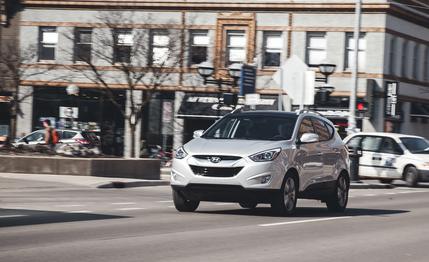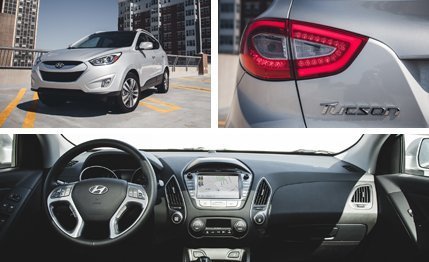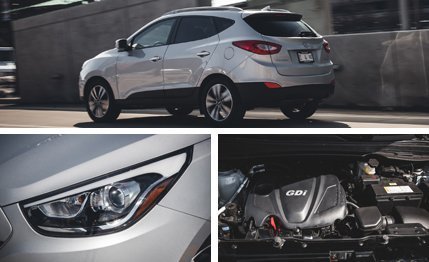
 Instrumented Test
Instrumented Test
News flash! Compact crossovers are a big showroom draw. We’ve begun to warm to this previously pedestrian segment thanks to excellent and fun-to-drive products such as Mazda’s CX-5, Ford’s Euro-sleek Escape, and the funky new Jeep Cherokee. Lost in this clamor is Hyundai’s current-generation Tucson, which hasn’t seen a freshening in nearly four years, the very period during which many excellent competitors have been redesigned or launched. That changes for 2014, however, with the Hyundai getting a subtle refresh and tweaked engines.
To measure the effectiveness of the Tucson’s late mid-cycle refresh, we tested a top-of-the-line, front-drive Limited model. The Limited comes with the larger of two available engines, a 2.4-liter four, while the mid-level SE version also gets the bigger motor and the base GLS trim uses an all-new 2.0-liter four.


A Segment Lightweight—Literally
This year, the 2.4-liter inherits direct fuel injection, netting it another 6 horsepower and 9 lb-ft of torque, for totals of 182 and 177. (The 2.0-liter loses one horsepower but gains 5 lb-ft of torque, also thanks to direct injection.) A six-speed automatic is standard on all models; the base manual transmission is gone, along with the entry-level GL trim level.
Thanks largely to its light-for-the-class curb weight of 3401 pounds, the Tucson scooted to 60 mph in a quick 7.8 seconds—a full second zippier than an all-wheel-drive 2013 Tucson that placed last in our most recent compact-SUV comparison test. (That Tucson was 20 pounds heavier than our 2014 test model, and was the lightest among the test’s five other contenders, helping it earn second-place acceleration honors.) Buyers can add all-wheel drive to any Tucson for $1500, a fair price for those who live where it snows.
Outside of the engine bay, the only other major change to the Tucson is the addition of Sachs amplitude-selective dampers, which Hyundai claims improves ride quality and handling. We noticed a slight improvement in the Tucson’s wheel and body control over rippled pavement, and the rig stays reasonably flat in corners, just as it did before. While certainly not “fun”—more driving satisfaction can be found behind the wheel of the CX-5 or Escape—the Tucson isn’t a dog, either. Unfortunately, weather prevented us from gathering grip data at the skidpad, but our test car rode on the same Kumho Solus tires as the aforementioned 2013 comparison-test contender, which posted a 0.77-g figure.


Hyundai’s Progress Marches On
Although Hyundai kept the Tucson’s nuclear-guppy styling intact, it added projector-beam headlights with LED flourishes, LED taillights (optional on Limited models only), and beige and brown paint options. We think the truck’s sheetmetal, which was almost extreme in 2010 when it debuted, has aged well, taking on more maturity as the competition grows increasingly more daring in this regard. The simple, well-built, and intuitive cabin has gained a standard tilting and telescoping steering wheel, cup-holder lights, and Hyundai’s Blue Link telematics system.
As far as refreshes go, the Tucson’s isn’t terribly comprehensive. But improvements were targeted where they were needed: the suspension and engine bay. Judged only against its competitors, the updated Tucson won’t rocket to the top of the segment, but taken in context with the other forces at work in the halls of Hyundai, we like what we see.


This is the same company that reached out to Lotus to help elevate the chassis dynamics of its second-generation Genesis luxury sedan, and the same company that’s nailed seemingly every bogey mid-size crossover shoppers are looking for with its updated Santa Fe. And keep in mind that Hyundai didn’t even sell cars in the U.S. before 1986. Today’s Hyundais no longer rely on a low price for appeal, which is why we won’t devote much space to the topic in this review (full pricing can be found here), beyond mentioning that our well-equipped $29,835 Limited model is priced in the thick of the compact SUV segment.
As Hyundai moves beyond a peddler of warranties and creature features wrapped in ho-hum cars, the competition should be concerned. In the not-too-distant future, it will fully redesign the Tucson, and then its other big sellers such as the Elantra. If Hyundai’s in-house people learn something about chassis dynamics from Lotus, the company’s products could become an even larger force in the market.